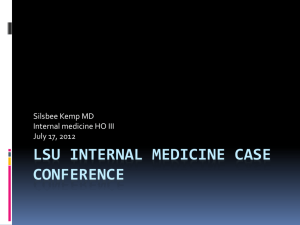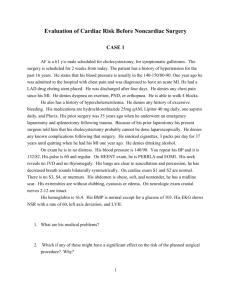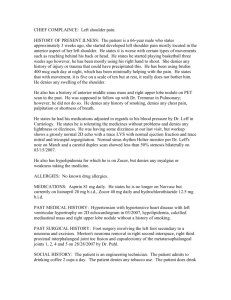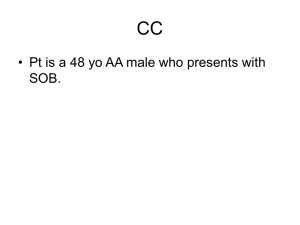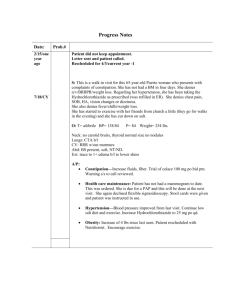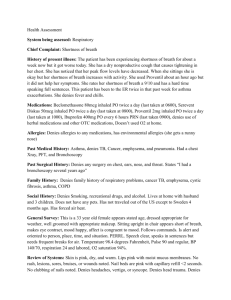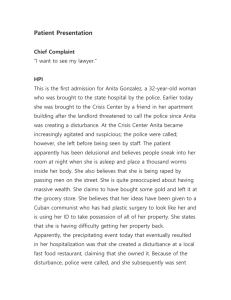Emergency Department SOAP Note: Hematuria & UTI
advertisement
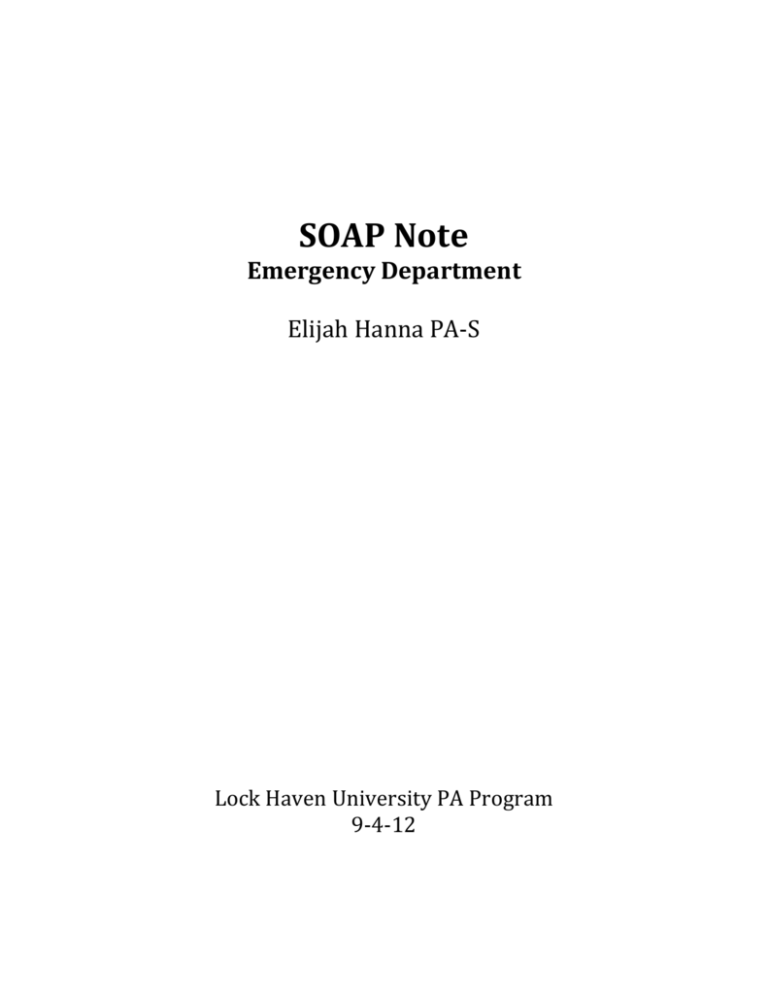
SOAP Note Emergency Department Elijah Hanna PA-S Lock Haven University PA Program 9-4-12 Name: ****** ***** MRN: ******** Race & Gender: Caucasian Male Insurance: Geisinger Gold Date Of Birth: 4/4/1937 Date: 9/4/2012 S: CC: “Blood in my urine since this morning” HPI: ****** ***** is a 75-year-old Caucasian male presenting to the ED complaining of blood in his urine starting this morning. He said this has never happened before, and he was scared when he saw blood throughout his entire void upon waking up this morning. The patient also complains of increased frequency and nocturia for the past two days, and denies ever having this before. He says he feels like he has to go at least once an hour, and about 2-3 times during the past two nights. Patient denies any dysuria, back or abdominal pain, retention or incomplete voids, weak or changed stream, changes in urine output, fouls smelling urine, urethral discharge or pain, or rectal pain or fullness. The patient denied any history of pyelonephritis, renal disorders, renal lithiasis, urinary tract infections, GI or GU malignancies, prostatitis, BPH, or STDs. The patient denied any changes in diet or eating beets, rhubarb, or blackberries. The patient denied any trauma or injury to his abdomen, back, or penis. He did not try anything to alleviate the symptoms other than drinking more water, and denies anything making them worse. He has only had one void with red colored urine, and has not voided since. Patient denies any recent illnesses, and hasn’t been to his PCP or an ED in over 4 years. PMH: The patient has a history of hypertension that was diagnosed 10 years ago. He initially was given blood pressure medication from his PCP, but discontinued it when he changed providers and hasn’t had medication for the last 4 years. Patient denies any history of anemia, CAD, DM, CVA, STDs, cancers, renal disorders, GI disorders, renal lithiasis, urinary tract infections, prostatitis, or BPH. Immunizations: Up to date. Gets a yearly influenza vaccine. Injuries: Fractured left radius in 2002. Surgeries: None. Hospitalizations: None. Medications: Bayer Back & Body (chronic osteoarthritis, PRN). Herbs/Vitamins: Octuvite (eye vitamin). Allergies: NKDA, No food or environmental allergies known of. Family History: Father, Deceased at 74 years old from Alzheimer’s Disease Mother, Deceased at 84 years old from Lung Cancer Paternal Grandfather, Deceased at 62 from an MVA Paternal Grandmother, Deceased at 61 from an MVA Maternal Grandfather, Deceased at 84 from an MI Maternal Grandmother, Deceased at 86 from a CVA Social History: Patient has been happily married to **** ***** for the last 50 years, and they have two daughters that are alive and well. He stays active playing with his 4 grandchildren and is an avid outdoorsman. He exercises daily with his wife at the local YMCA where he swims. He worked as a postal worker for 40 years, and is now retired and financially stable. The patient denies any history of alcohol, tobacco, or drug use. The patient says he has well-balanced diet, which includes many fruits and vegetables. R.O.S.: General: Patient denies any fevers, weight loss/gain, fatigue, weakness, appetite loss, chills, difficult sleeping or night sweats. Skin: Patient denies any rashes, itching, bruising, dryness, redness or lesions. Patient denies any other changes to hair, skin or nails. Respiratory: Patient denies any chest pain, dyspnea, cough, sputum production, hemoptysis, or history of infection of TB. Cardiac: Patient denies any chest pain, dyspnea on exertion, palpitations, murmurs or congenital abnormalities/complications. Abdominal: Patient denies any abdominal or rectal pain, changes in bowel movement activity or characteristics, light or dark colored stools, or rectal fullness. Genitourinary: (In HPI) Musculoskeletal: Patient denies any new or different joint pain, swelling, redness, or limitations in mobility. Patient denies any muscle pain, weakness, fasiculations, or atrophy. O: Vital Signs: Blood pressure- 212/102mmHg (L arm, sitting), Heart Rate- 84 bpm, Respiration Rate- 16 bpm, Temperature- 98.8 F (Temporal), SpO2- 97% (Room air), Weight- 88.45 kg (195 lb), Height- 1.778 m (5’10”) General: Patient appears as stated age, well developed, and in no acute distress. The patient is mild mannered, well spoken, and has no difficulty with any speech or social interaction. The patient is appropriately dressed and appears to have good hygiene. There are no abnormal olfactory or extracorpeal clues noted. Skin: There are no rashes, eruptions, bruising, redness, swelling, dryness or lesions. The hair is in appropriate distribution, smooth, and well kept. The nails reveal no clubbing, merckes lines, beaus lines, thickening, pallor, or pitting. Chest/Lungs: Inspection reveals no scars, lesions, masses, accessory muscle use or asymmetrical chest wall movements. Patient has no pain upon palpation, 1:2 AP/lateral ratio, and symmetrical respiratory excursion. Auscultation reveals clear, unlabored breath sounds in all lung fields and no adventitious sounds such as rales, ronchi, or wheezes. Cardiac: Inspection of precordium reveals no lifts, heaves or visible PMI. Palpation reveals no lifts, heaves, or thrills. Auscultation reveals regular rate and rhythm, S1, S2 and no murmurs, clicks, gallops or rubs. Abdominal: Inspection of the abdomen reveals no striae, ascites, scars, visible peristalsis, pulsations, or obvious masses. Auscultation reveals no bruits of the abdominal aorta, renal, external iliac, or femoral arteries. Bowel sounds are heard in all four quadrants or normal quality and equal intensity. Percussion reveals no hepatosplenomegaly, tenderness, or masses. The bladder was unable to be percussed. Palpation reveals no tenderness, masses, hepatosplenomegaly, or enlargement of the abdominal aorta. The kidneys were unable to be trapped. The patient had no CVA tenderness. A rectal examination reveals appropriate sphincter tone, no nodules or enlargement of the prostate, no bogginess or tenderness of the prostate, and heme negative stool. Genitourinary: Inspection reveals no redness, swelling, masses, or lesions of the penile shaft, glands, scrotum or testicles. There is no redness, lesions, or discharge noted at the urethra. Urinalysis: Component Color Clarity Glucose Bilirubin Ketone Specific Gravity Blood pH Protein Urobilinogen Nitrite Esterase Ictotest WBC RBC Value Red Cloudy Negative Small Negative 1.010 Large 5.5 100 Normal Negative Large Positive 20-29 20-29 A: Diagnosis: Urinary tract infection Differential Diagnosis: Renal lithiasis, GU malignancy, BPH, Intrinsic renal disease like ATN, Glomerulonephritis P: Pending Labs: CBC w/ differentiation, CMP Pending Imaging: None Treatment: Cipro 250 mg PO BID x’s 7 days Patient Education: Patient is told to continue his current medications, and to take the full course of the antibiotic prescribed above. Patient is educated on possibility of tendon rupture with the above antibiotic, and is told to follow up with a provider immediately if he develops any tendon pain. Patient is told to stay well hydrated by drinking 60-72 fluid ounces of water a day, and to self-monitor each void and pay particular attention to when the hematuria begins and ends in his stream. Patient was educated on possibility of the above differential diagnoses, and the importance of follow up with his PCP and Urologist. Patient understood the treatment plan, and had no further questions or concerns. Referrals/Consults: Patient given a phone number to call local Urologist Dr. *** ***** and set up an appointment within 5-7 days. Their office was called to send patient information with patient’s verbal and written consent. Provider Notes: Patient was diagnosed with a UTI in the absence of any bacteria noted on the initial UA. The abnormal protein levels may be falsely elevated due to the amount of RBC in the urine. The amount of RBC in the urine does not correlate with the severity of any disease process. The patient’s hematuria and proteinuria should continue to be monitored by his PCP and Urologist to exclude the possibility of other origins including renal parenchyma disease, glomerular disease, malignancy or the GU tract, or renal lithiasis. Urologist may want to perform cystoscopy sooner than later to increase chances of finding the origin of the hematuria. Follow Up: Patient is to follow up with his PCP within 3-5 days to coordinate treatment with the Urologist, monitor hematuria and proteinuria, and evaluate for hypertension. Patient is told to follow up at the ED if condition is worsening, patient develops severe pain, is unable to void, becomes lethargic or confused, or develops a fever or chills. Elijah Hanna PA-S (9/4/12)
